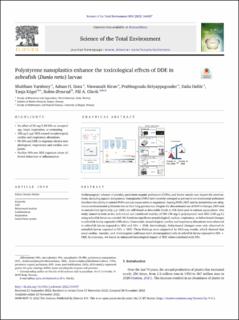Polystyrene nanoplastics enhance the toxicological effects of DDE in zebrafish (Danio rerio) larvae
Varshney, Shubham; Gora, Adnan Hussain; Viswanath, Kiron; Siriyappagouder, Prabhugouda; Dahle, Dalia; Kögel, Tanja; Ørnsrud, Robin; Olsvik, Pål Asgeir
Journal article, Peer reviewed
Published version

Åpne
Permanent lenke
https://hdl.handle.net/11250/3062056Utgivelsesdato
2023Metadata
Vis full innførselSamlinger
- Department of Biological Sciences [2235]
- Registrations from Cristin [9791]
Originalversjon
Science of the Total Environment. 2023, 859, 160457. 10.1016/j.scitotenv.2022.160457Sammendrag
Anthropogenic releases of plastics, persistent organic pollutants (POPs), and heavy metals can impact the environment, including aquatic ecosystems. Nanoplastics (NPs) have recently emerged as pervasive environmental pollutants that have the ability to adsorb POPs and can cause stress in organisms. Among POPs, DDT and its metabolites are ubiquitous environmental pollutants due to their long persistence. Despite the discontinued use of DDT in Europe, DDT and its metabolites (primarily p,p′-DDE) are still found at detectable levels in fish feed used in salmon aquaculture. Our study aimed to look at the individual and combined toxicity of NPs (50 mg/L polystyrene) and DDE (100 μg/L) using zebrafish larvae as a model. We found no significant morphological, cardiac, respiratory, or behavioural changes in zebrafish larvae exposed to NPs alone. Conversely, morphological, cardiac and respiratory alterations were observed in zebrafish larvae exposed to DDE and NPs + DDE. Interestingly, behavioural changes were only observed in zebrafish larvae exposed to NPs + DDE. These findings were supported by RNA-seq results, which showed that some cardiac, vascular, and immunogenic pathways were downregulated only in zebrafish larvae exposed to NPs + DDE. In summary, we found an enhanced toxicological impact of DDE when combined with NPs.
